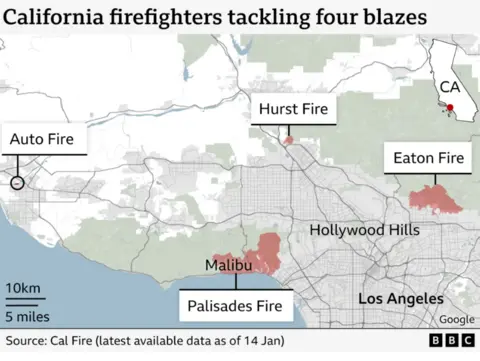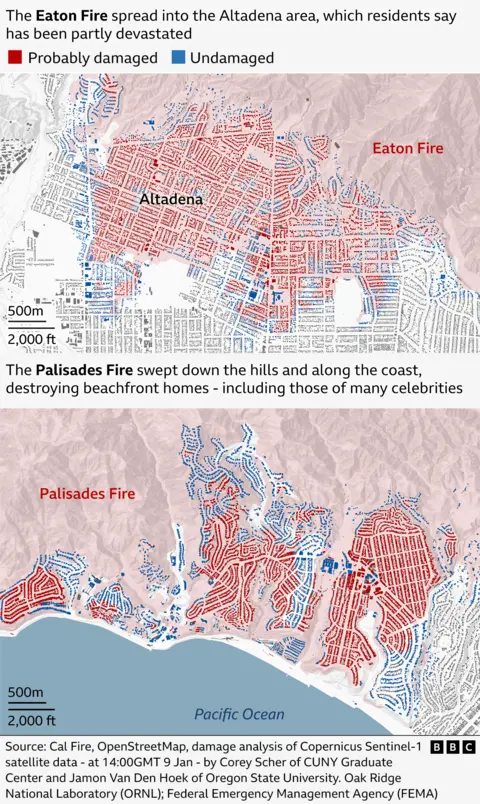Firefighters battling two fires that ravaged Los Angeles for nine days got some respite Thursday from the bad weather.
The near-hurricane-force winds that initially fanned the flames and hampered rescue efforts weakened to much lighter gusts.
Progress has been made to contain the two largest fires which have scorched a total area of approximately 40,000 acres.
At least 27 people were killed and more than 12,000 structures destroyed in some of the worst fires in memory that ravaged the second-largest city in the United States.
The two largest fires, Eaton and Palisades, are still burning after more than a week – and help from firefighters has been requested in Mexico and Canada.
“Please be assured that our firefighters continue to work 24/7 to completely contain these wildfires as quickly as possible,” Los Angeles County Fire Chief Anthony Marrone said during a press conference Thursday morning.
Officials said there has been little to no fire growth over the past 24 hours, but stressed that dry, unburned fuel combined with low humidity could pose a threat despite winds decreasing.
Marrone said that even if first responders make progress in putting out the flames, evacuated residents won’t be able to return to their neighborhoods for at least another week, even for areas deemed safe.
About 82,400 Californians are under evacuation orders, according to Los Angeles County Sheriff Robert Luna.
Mr Luna said there had been 47 arrests linked to looting, local evacuation orders and curfew violations.
Later Thursday afternoon, evacuation orders for some communities affected by the Palisades and Eaton fires were lifted — more than a week after they were first ordered.
Authorities said residents must prove their residency with a government-issued ID in order to be allowed to enter affected areas. They also advise residents to wear protective clothing, including gloves and a mask, and to avoid contact with potentially toxic ashes.
“Returning after a fire can be overwhelming,” the Altadena Sheriff’s Station said in a recent Facebook post offering advice to returning evacuees.
“Take breaks, check in with loved ones, and consider talking to a counselor or support group if necessary.”
Red flag warnings have been lifted by the National Weather Service (NWS), but could return in a few days.
Fire warnings remain critical, with parts of Southern California continuing to experience high risk despite weakening winds and increasing humidity, BBC weather forecaster Paul Goddard said.
No rain is forecast in California for next week.
Authorities are monitoring the Santa Ana winds, which are blamed for fanning the fires. Winds are expected to return early next week, bringing a high risk of further red flag warnings.
Winds could bring gusts of 30 to 50 mph (48 to 80 km/h).
The Palisades Fire, the largest, has seen no growth as firefighters work to contain the flames, according to Cal Fire incident manager Jim Hudson.
It has burned 24,000 acres to date and was more than 20% contained as of Thursday morning.
“I hope that as the winds subside, we can see a light at the end of the tunnel and that individuals can get their lives back on track to recover and rebuild,” the mayor of New York said Thursday. Los Angeles, Karen Bass.
But many risks remain in the area, even if firefighters are making progress.
Mr Hudson added that 5,100 people had been assigned to contain the fire.

Two more deaths from the fires were confirmed to the BBC on Thursday by Los Angeles officials. There are at least 31 active missing persons reports in Los Angeles County as of Thursday.
Most of the victims died in the Eaton Fire, which burned more than 14,000 acres north of the city. Firefighters contained 55% of the fire.
Some of the victims of the Eaton fire have now been allowed to return home, but tens of thousands of people are still under evacuation orders – where nighttime curfews also apply.
Thousands of homes were destroyed in one of the costliest natural disasters in American history.
An extreme weather attribution study carried out by climatologists at ‘Climatometer» concluded that the California wildfires were fueled by weather conditions enhanced by human-induced climate change.
The study found that current conditions are hotter, drier and windier than in the past in fire-affected areas.








